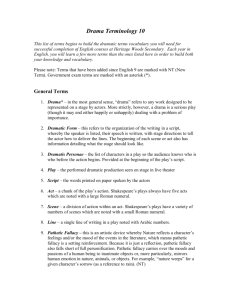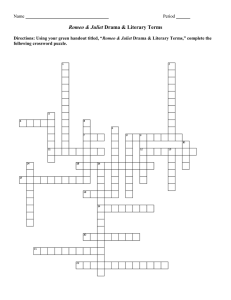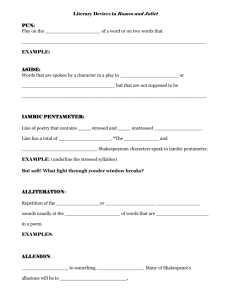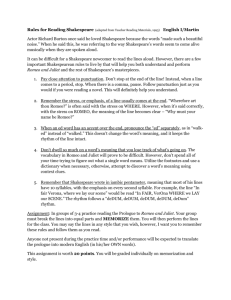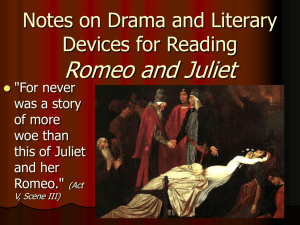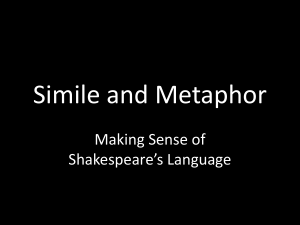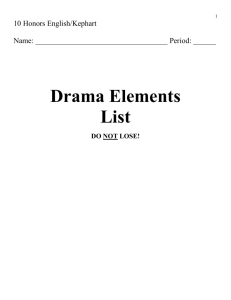Drama - SD43
advertisement
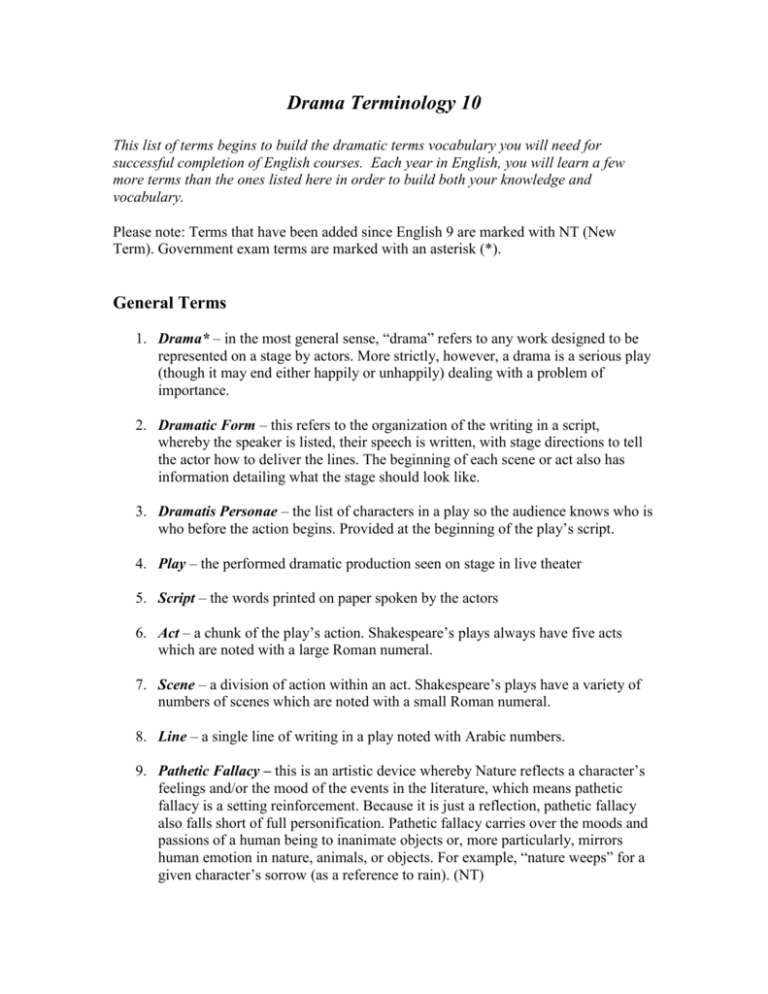
Drama Terminology 10 This list of terms begins to build the dramatic terms vocabulary you will need for successful completion of English courses. Each year in English, you will learn a few more terms than the ones listed here in order to build both your knowledge and vocabulary. Please note: Terms that have been added since English 9 are marked with NT (New Term). Government exam terms are marked with an asterisk (*). General Terms 1. Drama* – in the most general sense, “drama” refers to any work designed to be represented on a stage by actors. More strictly, however, a drama is a serious play (though it may end either happily or unhappily) dealing with a problem of importance. 2. Dramatic Form – this refers to the organization of the writing in a script, whereby the speaker is listed, their speech is written, with stage directions to tell the actor how to deliver the lines. The beginning of each scene or act also has information detailing what the stage should look like. 3. Dramatis Personae – the list of characters in a play so the audience knows who is who before the action begins. Provided at the beginning of the play’s script. 4. Play – the performed dramatic production seen on stage in live theater 5. Script – the words printed on paper spoken by the actors 6. Act – a chunk of the play’s action. Shakespeare’s plays always have five acts which are noted with a large Roman numeral. 7. Scene – a division of action within an act. Shakespeare’s plays have a variety of numbers of scenes which are noted with a small Roman numeral. 8. Line – a single line of writing in a play noted with Arabic numbers. 9. Pathetic Fallacy – this is an artistic device whereby Nature reflects a character’s feelings and/or the mood of the events in the literature, which means pathetic fallacy is a setting reinforcement. Because it is just a reflection, pathetic fallacy also falls short of full personification. Pathetic fallacy carries over the moods and passions of a human being to inanimate objects or, more particularly, mirrors human emotion in nature, animals, or objects. For example, “nature weeps” for a given character’s sorrow (as a reference to rain). (NT) 10. Stage Direction – a direction by the playwright to the actors in the script. It indicates how the actor should speak and/or move during a particular line or scene. It also provides descriptions of what the stage should look like in terms of furniture, weather, lighting, music, etc. 11. Monologue – a single fictional speaker – usually a performance actor - gives an extended speech, either as if alone on stage (like a Shakespearian soliloquy) or as if speaking to a fictional audience. The personality of the character and significant events in his/her life are revealed by the speech. If the speaker delivers the monologue to a fictional audience, the reader also gets information about that audience, because the monologue’s comments and questions allow the reader to infer information in that area. Also known as monodrama. 12. Dialogue* – when two or more speakers speak to one another; the spoken exchanges that comprise a play. 13. Dramatic irony* – when a character says something, but the audience knows more than the character does about other characters or events, so the statement comes across with a double meaning that the audience “gets” and the character doesn’t. It is dramatic irony when Juliet first sees Romeo and says if she can’t marry him, she will die, because the audience knows that by the end of the play she does marry him, and she dies anyway. The character’s expectations and the audience’s knowledge differ in dramatic irony. (NT) Terms Derived From Studies of Shakespeare 14. Blank Verse – unrhymed iambic pentameter. Shakespeare’s plays are mostly written in blank verse. See below for a definition of iambic pentameter. (NT) 15. Aside* – when a character says something privately to another character while other characters are also on stage. The line(s) are meant for one character’s ears alone. Sometimes asides are addressed to the audience. 16. Comic Relief – a humorous scene, incident, or remark within an essentially serious or even tragic drama. Following scenes of intense emotion, comic relief evokes laughter as a release from the tension of the serious action. (NT) 17. Iambic Pentameter – a line of poetry which is ten syllables in length. The syllables follow a pattern in which an unstressed syllable is followed by a stressed one (such as the word “giraffe”), so the line of poetry bounces gently along (softhard-soft-hard-soft-hard-soft-hard-soft-hard). For example, when Romeo says, “O, she doth teach the torches to burn bright” (Romeo and Juliet, I.v.44), he is speaking in iambic pentameter. (NT) 18. Prologue – an opening section of a longer work such as a novel or a play. The prologue may perform a number of functions: establish and/or anticipate character, theme, action or setting, etc. Romeo and Juliet opens with a prologue, which is in the form of a sonnet. See your poetry terms handout for the definition of sonnet. (NT) 19. Pun – this is a play on words in which a word or phrase can be taken to mean more than one thing. 20. Soliloquy – when a character speaks his/her true thoughts and feelings while alone on stage. Soliloquies reveal the character’s “real” thoughts on a subject. Terms Derived From Studies of Greek Drama 21. Chorus – originally a group of masked male dancers who sang or chanted as part of ceremonies in Greek drama, the chorus was imitated by the Elizabethans and often reduced to a single figure. In Shakespeare’s Romeo and Juliet the chorus speaks the prologue and introduces Act 2. Choruses are rare in modern plays. (NT) 22. Comedy* – any literary work, but especially a play, that commonly has a happy ending. Modern comedies tend to be funny, while Shakespearean comedies simply end well. Shakespearean comedy also contains items such as misunderstandings and mistaken identity to heighten the comic effect. Often, comedies end in marriage(s). A Midsummer Night’s Dream is a comedy. 23. Tragedy* – Aristotle defines tragedy as an imitation of a complete action “of high importance” (trans. L. J. Potts). Tragedy is a form of drama exciting pity and/or fear in the audience; as a result, viewers are provided with an experience of catharsis or cleansing of emotions. Not only should a tragedy’s action be single and complete, it should be written in poetry embellished with every kind of artistic expression, involve persons of stature, and present a reversal of Fortune. Romeo and Juliet (grade ten) and Macbeth (grade eleven) are tragedies. (NT)
